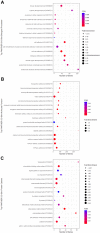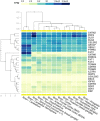Exonic mutations in cell-cell adhesion may contribute to CADASIL-related CSVD pathology
- PMID: 37422595
- PMCID: PMC10449969
- DOI: 10.1007/s00439-023-02584-8
Exonic mutations in cell-cell adhesion may contribute to CADASIL-related CSVD pathology
Abstract
Cerebral autosomal dominant arteriopathy with subcortical infarcts and leukoencephalopathy (CADASIL) is a condition caused by mutations in NOTCH3 and results in a phenotype characterised by recurrent strokes, vascular dementia and migraines. Whilst a genetic basis for the disease is known, the molecular mechanisms underpinning the pathology of CADASIL are still yet to be determined. Studies conducted at the Genomics Research Centre (GRC) have also identified that only 15-23% of individuals clinically suspected of CADASIL have mutations in NOTCH3. Based on this, whole exome sequencing was used to identify novel genetic variants for CADASIL-like cerebral small-vessel disease (CSVD). Analysis of functionally important variants in 50 individuals was investigated using overrepresentation tests in Gene ontology software to identify biological processes that are potentially affected in this group of patients. Further investigation of the genes in these processes was completed using the TRAPD software to identify if there is an increased number (burden) of mutations that are associated with CADASIL-like pathology. Results from this study identified that cell-cell adhesion genes were positively overrepresented in the PANTHER GO-slim database. TRAPD burden testing identified n = 15 genes that had a higher number of rare (MAF < 0.001) and predicted functionally relevant (SIFT < 0.05, PolyPhen > 0.8) mutations compared to the gnomAD v2.1.1 exome control dataset. Furthermore, these results identified ARVCF, GPR17, PTPRS, and CELSR1 as novel candidate genes in CADASIL-related pathology. This study identified a novel process that may be playing a role in the vascular damage related to CADASIL-related CSVD and implicated n = 15 genes in playing a role in the disease.
© 2023. The Author(s).
Conflict of interest statement
The authors declare that the research was conducted in the absence of any commercial or financial relationships that could be construed as a potential conflict of interest.
Figures


Similar articles
-
Investigating a Genetic Link Between Alzheimer's Disease and CADASIL-Related Cerebral Small Vessel Disease.Mol Neurobiol. 2022 Dec;59(12):7293-7302. doi: 10.1007/s12035-022-03039-3. Epub 2022 Sep 29. Mol Neurobiol. 2022. PMID: 36175824 Free PMC article.
-
Targeted exonic sequencing identifies novel variants in a cerebral small vessel disease cohort.Clin Chim Acta. 2025 Feb 1;567:120120. doi: 10.1016/j.cca.2024.120120. Epub 2024 Dec 30. Clin Chim Acta. 2025. PMID: 39743006
-
Cerebral autosomal dominant arteriopathy with subcortical infarcts and leukoencephalopathy: two novel mutations in the NOTCH3 gene in Chinese.J Neurol Sci. 2006 Jul 15;246(1-2):111-5. doi: 10.1016/j.jns.2006.02.011. Epub 2006 Mar 31. J Neurol Sci. 2006. PMID: 16580020
-
A Novel Heterozygous Variant in Exon 19 of NOTCH3 in a Saudi Family with Cerebral Autosomal Dominant Arteriopathy with Subcortical Infarcts and Leukoencephalopathy.J Stroke Cerebrovasc Dis. 2020 Jul;29(7):104832. doi: 10.1016/j.jstrokecerebrovasdis.2020.104832. Epub 2020 May 13. J Stroke Cerebrovasc Dis. 2020. PMID: 32414585 Review.
-
[Cerebral autosomal dominant arteriopathy with subcortical infarcts and leukoencephalopathy (CADASIL)].Rinsho Byori. 2009 Mar;57(3):242-51. Rinsho Byori. 2009. PMID: 19363995 Review. Japanese.
Cited by
-
A Search for New Biological Pathways in Cerebral Autosomal Dominant Arteriopathy with Subcortical Infarcts and Leukoencephalopathy by Proteomic Research.J Clin Med. 2024 May 27;13(11):3138. doi: 10.3390/jcm13113138. J Clin Med. 2024. PMID: 38892848 Free PMC article.
References
-
- Benton MC, Smith RA, Haupt LM, Sutherland HG, Dunn PJ, Albury CL, et al. variant call format-diagnostic annotation and reporting tool: a customizable analysis pipeline for identification of clinically relevant genetic variants in next-generation sequencing data. J Mol Diagn. 2019;21(6):951–960. doi: 10.1016/j.jmoldx.2019.07.001. - DOI - PubMed
MeSH terms
Substances
Grants and funding
LinkOut - more resources
Full Text Sources
Research Materials
Miscellaneous

